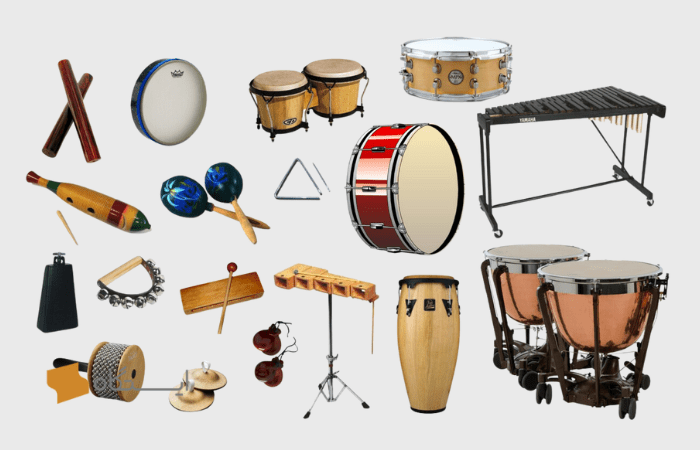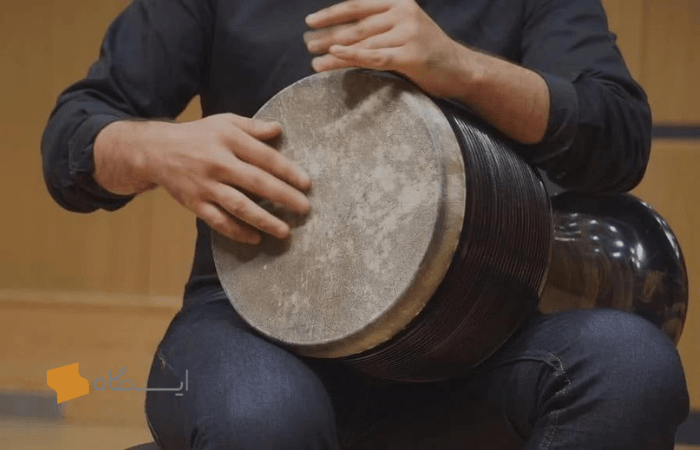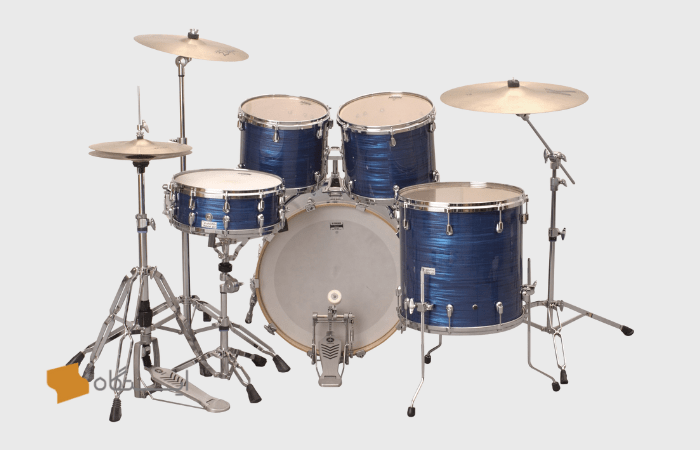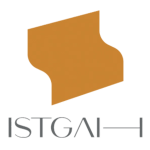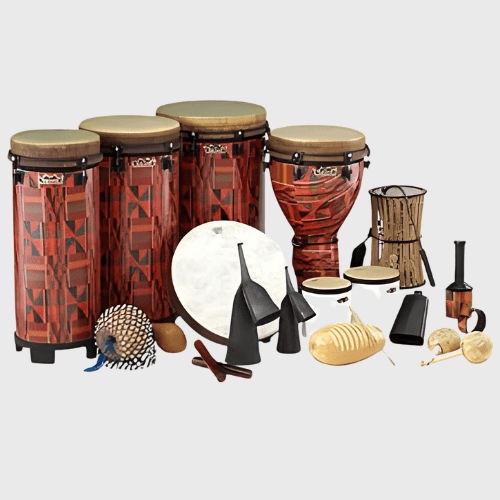
17 ژوئن 9 best iranian and foreign percussion instruments
Percussion instruments, also known as membraphones, are played by striking, shaking, or scraping with hands, sticks, or other implements. Iranian music features two categories of these instruments, national and local, each with a thousand-year history.
These instruments produce high-pitched sounds due to their structure and method of play, creating a unique blend with lower-pitched instruments. Besides maintaining rhythm, percussion instruments can also play melodies. They are divided into two categories: those with a definite pitch and those with an indefinite pitch.
Percussion instruments fall into two broad categories: those with a definite pitch and those with an indefinite pitch. Both types play crucial roles in music and are used in various musical styles.
Definite pitch instrument
Definite pitch percussion instruments can produce specific and precise notes. They typically have vibrating skins or plates that generate highly accurate musical notes. The xylophone, which has wooden or metal bars each producing a specific note, is a well-known instrument in this category. The marimba and vibraphone, similar in structure to the xylophone but made from different materials, also belong to this category.
Indefinite pitch instruments
Indefinite pitch percussion instruments do not produce precise notes and are primarily used for rhythm and sound effects. These instruments often have stretched skins or bodies made of metal or wood that are struck to produce sound. Drums, tambourines, maracas, and castanets are examples of these instruments.
These instruments are used in all types of music, including pop, rock, folk, and classical. For instance, drums are essential in rock and pop music for maintaining rhythm and producing heavy beats. The cajón is a simple yet widely used percussion instrument in flamenco music and other styles, where the musician creates various sounds by sitting on it and striking different parts of the instrument.
the main difference between definite and indefinite pitch instruments
The main distinction between these two categories is the ability to produce accurate notes. Percussion instruments with a definite pitch can play melodies and harmonies, while those with an indefinite pitch are more often used to create rhythm and sound effects. These differences allow each type of instrument to play a unique role in different musical contexts, and their combination in a performance can add more variety and richness to the music.
Percussion instruments have long captivated musicians and listeners, adding depth, texture, and excitement to music with a wide range of sounds. These instruments are typically used to maintain rhythm in performances, but due to their high flexibility, they can also perform beautiful solos. From traditional drums and tambourines to jingles and energetic maracas, percussion instruments play a crucial role in creating rhythm and enhancing emotion in music. Percussion instruments hold a prominent place not only in local and religious music but also in modern and global genres, and they are included in both Iranian and foreign percussion instruments, which we will introduce below.
Types of Iranian percussion instruments include:
Daf: A traditional Iranian percussion instrument, the Daf has a simple structure but a rich and attractive sound. This instrument is circular with a wooden frame and skin stretched over it. The Daf, one of the oldest Iranian instruments, plays an important role in mystical music and religious ceremonies.
Tonbak: Known for its cylindrical shape and skin stretched over its mouth, the Tonbak is a traditional Iranian percussion instrument. This instrument is primarily made of wood, and its skin is made of animal skin such as goat or sheep. The sound of the Tonbak is produced with hands and fingers, and the musician creates various rhythms using different techniques.
Zarb Zorkhaneh: A traditional Iranian percussion instrument, the Zarb Zorkhaneh plays a key role in the music and martial rituals of Zorkhanehs. This instrument consists of a large copper pot and a tanned skin that is stretched over the opening of the pot. Zorkhaneh playing is done by the teacher who mastered the rhythms and accompanies and guides the various strikes, movements, and exercises of the wrestlers.
Tabl: One of the oldest percussion instruments, the drum holds a special place in different cultures and musics of the world. This instrument is cylindrical and consists of a body and two shells. The main feature of the drum is its loud and resonating sound, which is produced by hitting the shells with hands or sticks.
Dohol: The Dohol is an ancient percussion instrument used in many cultures, particularly in South Asia and the Middle East. This cylindrical wooden instrument, similar to a drum but smaller, has both ends covered with animal skin. It is played using two sticks, a thinner one for the smaller skins and a thicker one for the larger skins. The Dohol is known for its powerful bass sound that resonates well in open spaces. It is primarily used in local ceremonies, celebrations, weddings, and religious rituals, playing a crucial role in creating rhythm and energy in music. It also accompanies traditional dances and performances, adding a special touch to these events.
Foreign Percussion Instruments:
Drum: The drum is a widely used percussion instrument in various types of music. It consists of a stretched shell on a frame that produces sound when struck. Drums come in different forms such as traditional drums, jazz drums, and electronic drums. A key feature of the drum is its ability to produce diverse rhythms and patterns that form the foundation of many musical styles. Drums are used in a variety of settings such as live performances, music recordings, and even music therapy. For instance, electronic drums, with their adjustable volume and digital system connectivity, are extensively used in modern music production and recording studios. Drums are also used as an educational tool to enhance motor coordination and concentration.
Hang Drum: The Hang Drum is a new and comprehensive type of percussion instrument that has quickly found its place in world music due to its unique appearance and sound. This instrument, part of the family of tubular instruments, is similar to the Dombeks but stands out due to its spherical shape and one or two grooves on top. The Hang Drum produces a live sound when its surface is touched or struck. These sounds, often associated with nature and peace, are typically used in meditation and relaxing music. The Hang Drum is also used as a passive tool in concentration sessions, meditation, and mental focus. Its simple structure and portability have quickly made it popular among musicians and music enthusiasts.
Cajón: The Cajón is a unique Spanish percussion instrument made of cedar wood or bamboo. One of its prominent features is its design, which resembles a box or a vertical arch with sharp points. The sound of this instrument is created using special playing methods, such as flexibility and pressure on the string, resulting in a special and comprehensive sound. The Cajón is used in various types of Iranian traditional and local music, including Bakhtiari, Lori, Kurdish music, and even in some modern songs. Its pleasant and emotional sound creates a sense of passion and energy in the audience, giving it a special place in the Iranian music culture.
Tempo: The Tempo is a new generation of musical instruments that combines technology and traditional sounds. Using sensor and software technology, this instrument can produce diverse and comprehensive sounds. The unique feature of the Tempo is the ability to program and adjust sounds as desired. Users can change various parameters including sound classifications, effects settings, and even rhythmic patterns using a simple user interface. The Tempo is used as a new tool in creating music. From professional artists to music enthusiasts, this instrument is used to record, perform, and produce music. Its easy portability and flexibility in live performances have garnered much attention. The Tempo is also used as an educational tool to help people improve their musical skills and enhance their creativity in music production.
conclusion
In conclusion, percussion instruments, also known as membraphones, are sounded by shaking, hitting, rubbing, scratching, or similar actions. In Iranian music, these instruments fall into two categories, national and local, each with a thousand-year history. Besides maintaining rhythm, these instruments can also play melodies. They are divided into two categories: those with a definite pitch and those with an indefinite pitch, each playing an important role in music. Percussion instruments with a definite pitch produce precise notes, while those with an indefinite pitch are used more to create rhythm and sound effects. This article analyzed different types of Iranian and foreign percussion instruments separately. Thank you for staying with us until the end of this article; stay tuned to Istgah.

